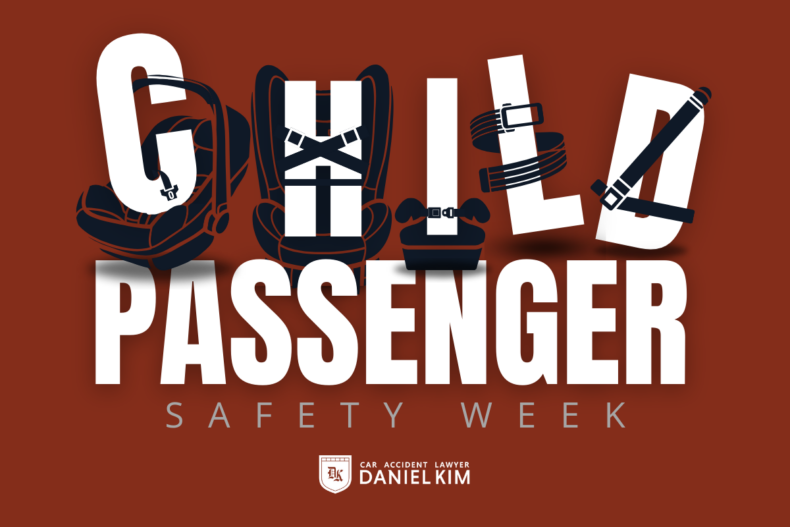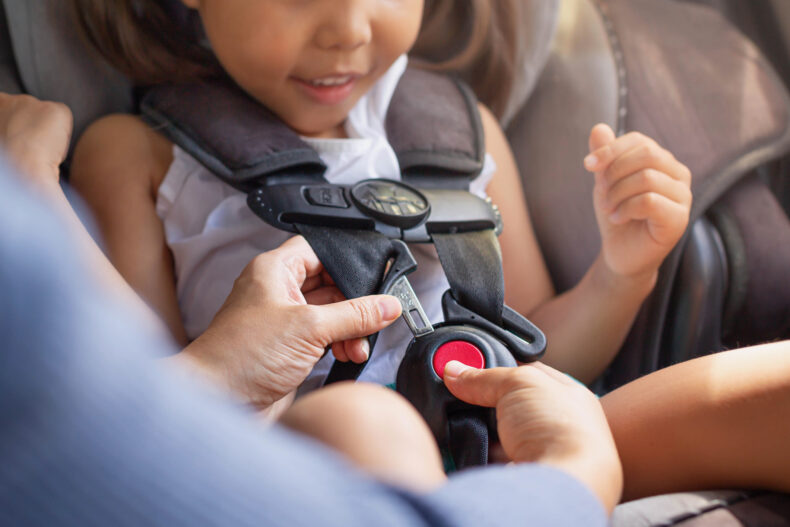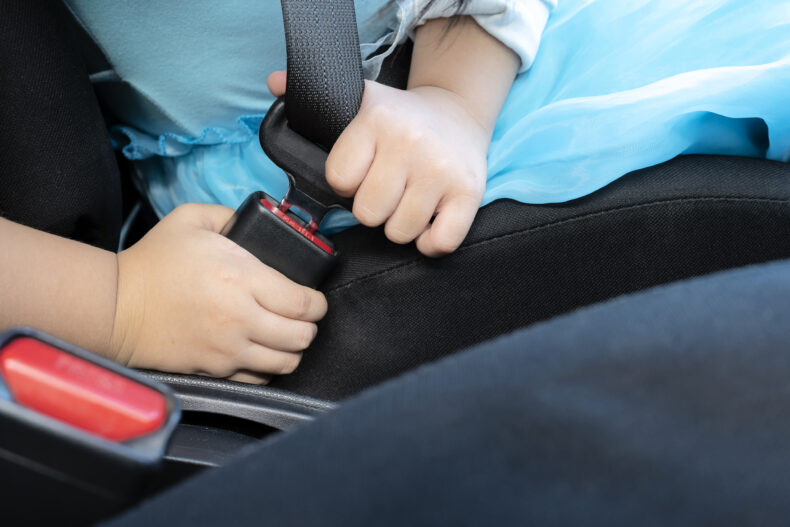California Child Safety Seat Laws
Did you know that child car seats, when used properly, have proven to reduce fatal injuries by 71% in infants and 54% in toddlers?
Child seat safety involves more than simply following the law. Continue reading to learn about car seat laws seat laws, car seat types, and the best practices to ensure your child’s safety on the road.
California Car Seat Laws
Under California car seat law, any child under the age of 2 must be secured in a rear-facing car seat in a motor vehicle unless they are 40” or taller or weigh 40 pounds or more. In addition, the specifications of the seat by the manufacturer should also be followed.
Children under the age of 8 must be secured in a car or booster seat and placed in the back seat of the vehicle. A booster seat is no longer needed at age 8 or when the child is 4’9″ or taller. However, they must still abide by safety seat belt laws.
Registering Your Child’s Car Seat
It isn’t enough to buy a car seat and ensure it is set up safely. You should also register your child’s car seat with the manufacturer. When you register your product, you will receive notifications if there are any recalls.
Car seat recalls are, fortunately, rare, but registration is one of the best ways to protect your child from unknown dangers. Most manufacturers have phone numbers for registration in their information and installation booklets or places on their websites.
Recalls from major, well-known brands have been issued within the last few years. This was due to various issues that could cause the safety seat to fail in the event of a crash. You can look up the product number and possible recall history to confirm if your child safety seat has been found to be defective. If the seat was registered, you should receive a notice about any product issues.
Types of Car Seats
There are multiple car seats explicitly designed for children of all age ranges, sizes, and weights. These are the safety seat types from infancy through childhood.
Rear-facing Car Seat
Rear-facing car seats are designed for infants until between the ages of 2-4 or when the child weighs between 22-35 pounds, depending on the specific model. These seats typically have a base that remains installed and handles to be used as a carrier.
The seat faces the rear of the car, so in the event of a crash, it will offer the best support for infants and toddlers and absorb most of the impact. The most common injuries in adults after car accidents are to the neck and head.
Therefore, a rear-facing car seat protects against these injuries as the whole body is protected by the shell of the seat, and it moves all at once in response to collision or impact. This is crucial as babies do not have the muscle tone to hold their heads up for support.
A rear-facing car seat should never be placed in the front seat of a car with an active front airbag. If the airbag were deployed, its force hitting the car seat could cause injury or even death.
Forward-facing Car Seat
Children should be kept in rear-facing car seats for as long as possible as they are the safest type. While it depends on the height, weight, and local laws, children are typically switched to a forward-facing car seat by the age of four at the latest. California follows the 4-40-40 rule to judge whether your child is able to graduate to a front-facing seat. The rule stands for:
- 4 or more years old
- 40 or more inches tall
- 40 or more pounds
It is essential to know how to install these safety seats and how to use the straps and buckles. Always use the manufacturer’s instructions for installing the product using either the seat belt or LATCH system. You can always contact your local California Highway Patrol office and ask to speak with a child passenger safety technician.
Additionally, when strapping your child in during winter, remove bulky outer layers like coats and snowsuits. These thick layers may make it difficult to make the straps as tight as they need to be. In the event of a car accident, the straps could be too loose, resulting in injury.
Booster Seat
Children typically outgrow forward-facing safety seats when they reach around 65 pounds. However, be sure to read the car seat owner’s manual to determine height and weight limits. Once your child outgrows their forward-facing car seat, they must be secured in a booster seat. Booster seats raise children up, so the safety belt crosses their body in the optimal position for safety.
You no longer need to have your child use a booster seat once the safety belt fits as it should. A properly fitting seat belt should go over the upper thighs and across the center of the chest and shoulder.
The standard seat belts in cars today have been designed to fit and protect the bodies of an average-sized adult man. So, transitioning from the booster seat to a regular seat belt is not a decision to take lightly.
Car Seat Expiration Dates
Did you know that car seats expire? It may seem odd that a product like a child’s safety seat could expire, but it is actually a guideline decided by car seat manufacturers. Car seats change and update according to changes in regulations, improvements in technology, or design choices.
Car seats passed down or traded between family members may look safe and seem to work just fine. However, used safety seats could be missing pieces, have unknown damage, or not work as well as newer models. The car seat will have a sticker, usually on a side or the base indicating the manufacture date.
Car seats are usually approved for six years before expiration. Convertible and 3-in-1 car seats typically have long expiration periods. Therefore the shelf-life, especially higher quality ones, is typically 7-10 years.
When Can My Child Sit in the Front Seat in California?
According to California state law, children must be seated in the rear seat of a vehicle in an appropriate car seat or booster seat until they are 8 years old or 4’9″ tall.
After your child turns 8 years old, they may ride in the front seat. However, many safety experts recommend keeping children in rear seats until they turn 13 years old.
Child Passenger Safety Week
Child seat safety is essential not only for your young ones, but also for everyone else in the car. An unsecured child could pose a distraction to the driver or get seriously hurt. Additionally, the fines for driving without a car seat in California are expensive, ranging from $100-$500.
The importance of car seat safety is highlighted every third week in September, known as Child Passenger Safety Week. This week serves as a great reminder for parents or childcare workers to check if their car seat is properly installed and safe.
If you were in a car accident with your child at the fault of another driver, you may be eligible for compensation. To learn more about California’s safety laws and actions to take following a car accident, schedule a free consultation with a Costa Mesa car accident lawyer today.
START YOUR FREE CONSULTATION




